In the realm of raptors, two remarkable birds stand out: the osprey and the falcon. Both species belong to the order Falconiformes and captivate with their aerial prowess and hunting skills.
However, despite some superficial similarities, ospreys, and falcons possess distinct characteristics that set them apart.
This article delves into the world of these magnificent birds of prey, exploring their physical attributes, hunting techniques, and habitats.
By examining their unique adaptations and behaviors, we can gain a deeper understanding of the osprey and falcon and appreciate the remarkable diversity found within the avian world.
Join us on this journey as we unravel the fascinating differences between these aerial predators and uncover the secrets behind their remarkable survival strategies.
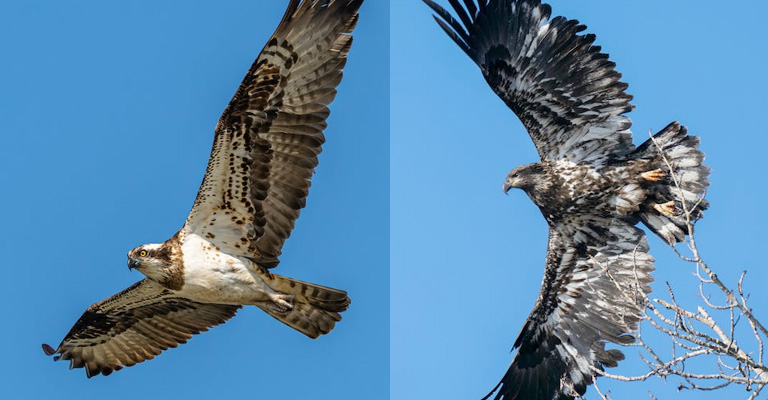
Ospreys: A Short Overview
Ospreys, scientifically known as Pandion haliaetus, are majestic birds of prey that belong to the family Pandionidae. They are characterized by their unique physical features and remarkable hunting abilities.
With a wingspan of up to six feet (1.8 meters) and a length of around two feet (60 centimeters), ospreys are relatively large birds. Their bodies are slim and streamlined, with long, powerful wings and sharp talons.
Preferred Habitat Near Large Bodies of Water
Ospreys are primarily found near large bodies of water, such as lakes, rivers, and coastlines. These habitats provide them with an abundant source of their favorite prey: fish.
Ospreys are particularly skilled at hunting and catching fish, which is why they are often referred to as fish eagles or fish hawks. Their specialized adaptations make them perfectly suited for life near water.
Hunting Behavior and Specialization in Catching Fish
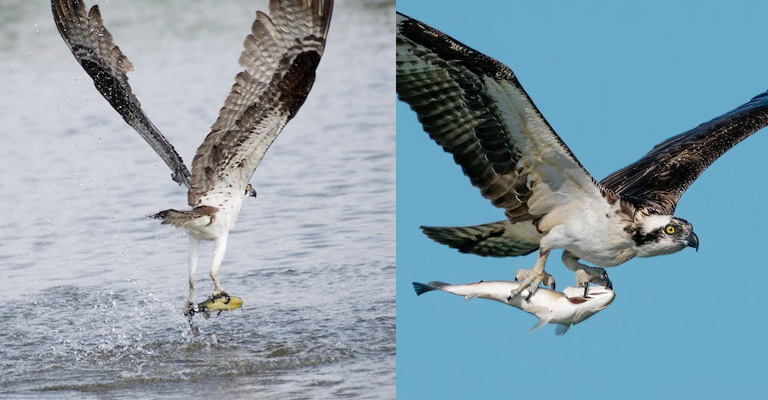
The hunting behavior of Ospreys is truly remarkable. They have several adaptations that enable them to excel at catching fish. Ospreys possess reversible outer toes, which allow them to grasp their prey with two toes in front and two toes behind.
This unique foot arrangement provides a strong and secure grip on slippery fish. Additionally, ospreys have barbed pads on the soles of their feet to further aid in gripping their catch.
When hunting, ospreys soar high above the water, using their keen eyesight to spot fish swimming near the surface. Once they locate a target, they hover momentarily before plunging into the water feet-first, creating a spectacular splash.
Their wings fold back to reduce drag, and they submerge briefly to grab the fish with their powerful talons. With their catch secured, ospreys take to the air once again, maneuvering to optimize their flight with the added weight.
Strength and Size Compared to Other Birds of Prey
Ospreys are renowned for their strength and agility. Their muscular bodies and powerful wings allow them to fly swiftly and with great precision. Compared to other birds of prey, ospreys are larger and stronger than many species of hawks and falcons.
While they may not possess the extraordinary speed of peregrine falcons, ospreys compensate with their size and strength, making them formidable hunters in their own right.
In the realm of birds of prey, ospreys stand out as skilled fish hunters that have adapted to thrive near water. Their physical characteristics, hunting behavior, and preference for large bodies of water make them unique and fascinating creatures to observe and study.
Falcons: A Short Overview
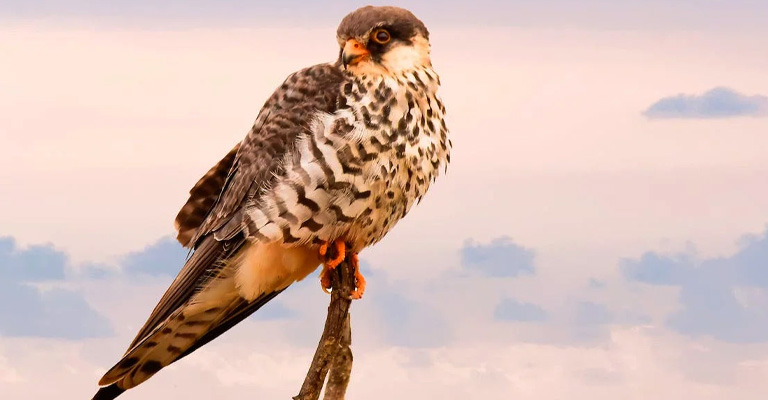
Falcons are a group of birds of prey known for their remarkable speed and agility. Among falcons, the peregrine falcon (Falco peregrinus) holds the distinction of being the fastest animal on Earth.
Peregrine falcons are renowned for their extraordinary speed during high-speed dives, making them an intriguing subject of study and admiration.
Physical Features and Unique Adaptations for Speed and Flight
Falcons possess several physical features and adaptations that contribute to their impressive speed and flight capabilities. They have slender bodies and long, pointed wings that allow for swift and efficient aerial maneuverability.
Falcon species often have streamlined body shapes, reducing air resistance and enabling them to reach incredible speeds.
Their strong, curved beaks are adapted for tearing into prey, while their sharp talons assist in catching and grasping their targets.
Habitat Preferences, Particularly High Places
Falcons exhibit specific habitat preferences, often favoring high places for nesting and hunting. Many species, including peregrine falcons, are commonly found nesting on cliffs, where they can establish eyries (nests) in protected locations.
Urban areas, such as tall buildings and bridges, also serve as suitable habitats for falcons due to their resemblance to natural cliffs. These elevated locations provide them with vantage points for hunting and nesting.
Hunting Techniques and the Significance of High-speed Dives
Falcons are known for their hunting prowess and unique hunting techniques. Peregrine falcons, in particular, employ a hunting strategy called stooping.
Stooping involves an impressive high-speed dive from great heights toward their prey. During this dive, peregrine falcons can reach speeds exceeding 240 miles per hour (386 kilometers per hour), making them the fastest animals on Earth.
This incredible speed enables them to swiftly close in on their target, delivering a powerful strike to capture their prey mid-flight.
The high-speed dives of falcons are a crucial aspect of their hunting success. The impact force generated during the stoop is instrumental in stunning or disabling their prey, ensuring a successful capture.
Falcons’ exceptional speed and precision during these dives make them formidable predators in the avian world. Falcons, with their impressive speed, aerial agility, and specialized hunting techniques, exemplify the extraordinary adaptations found in birds of prey.
Their physical characteristics, habitat preferences, and hunting strategies highlight the unique and awe-inspiring nature of these remarkable birds.
Comparison: Ospreys Vs. Falcons
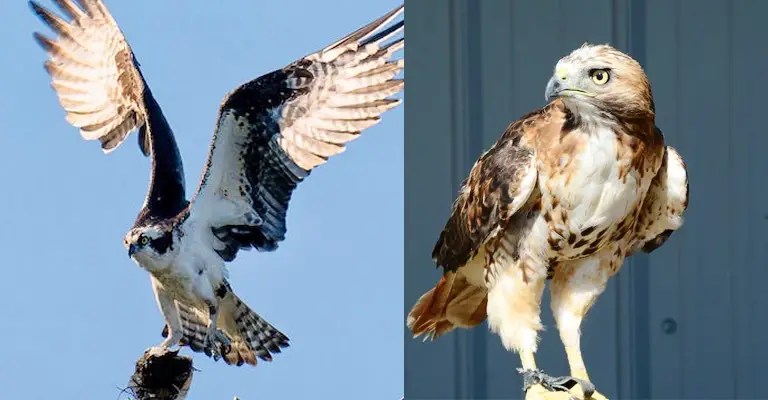
In the following criteria, you will find the basic differences between these two species.
Differences in Size, Speed, and Hunting Strategies
Ospreys and falcons exhibit significant differences in various aspects, including size, speed, and hunting strategies. Ospreys are larger birds, with a wingspan of up to six feet and a length of around two feet.
In contrast, falcons are generally smaller in size, though their specific sizes can vary depending on the species. This distinction in size contributes to differences in their hunting techniques and prey preferences.
Osprey’s Advantage in Strength and Talons for Catching Fish
One advantage that ospreys possess is their strength and specialized talons, which are well-suited for catching fish. Ospreys have powerful muscles and sharp, curved talons that enable them to grip fish firmly.
Their talons have adapted to have barbed pads on the soles, providing an enhanced grip on slippery fish. This advantage allows ospreys to plunge into the water and secure their catch with precision, making them highly efficient fish hunters.
Falcon’s Advantage in Speed, Agility, and Aerial Hunting Techniques
Falcons, particularly the peregrine falcon, excel in speed, agility, and aerial hunting techniques. Falcons are known for their exceptional flight capabilities, including their ability to reach incredible speeds during dives.
Peregrine falcons, in particular, can achieve speeds of over 240 miles per hour, making them the fastest animals on Earth.
Their agility and maneuverability in the air enable them to pursue and capture fast-moving prey such as birds in mid-flight.
Hypothetical Scenarios: Osprey Vs. Falcon
In hypothetical scenarios of an encounter between an osprey and a falcon, several factors would come into play. The osprey’s strength and powerful talons would provide an advantage in terms of gripping and overpowering the falcon.
However, the falcon’s speed, agility, and aerial hunting techniques would allow it to launch surprise attacks and potentially outmaneuver the osprey.
The outcome would depend on various factors, including the specific species involved, their health and condition, and the circumstances of the encounter.
Potential Outcome of a Fight
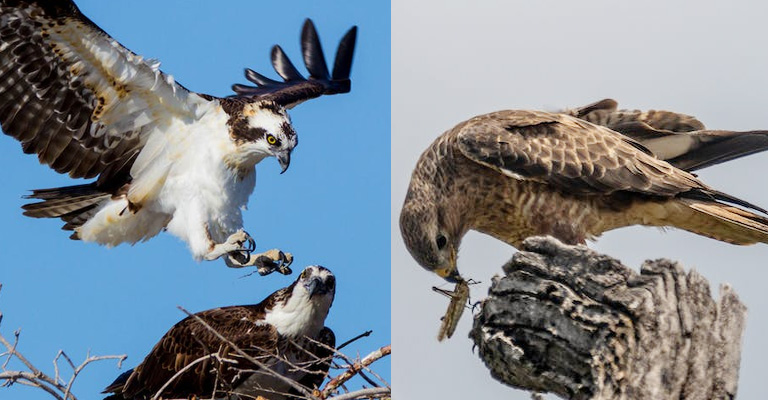
Analyzing the outcome of a fight between an osprey and a falcon involves considering various factors. One crucial factor is the specific species of falcon involved, as different falcon species have varying sizes, speeds, and hunting techniques.
The health, condition, and age of both birds would also play a role. Additionally, the circumstances of the fight, such as the environment and the availability of resources, could impact the outcome.
Importance of Falcon’s Speed and Diving Abilities
The falcon’s speed and diving abilities are significant advantages in a potential fight. Falcons, particularly peregrine falcons, can reach remarkable speeds during dives, allowing them to launch surprise attacks on their prey.
Their agility and precision in flight make it challenging for other birds to defend against their swift strikes. In a fight, the falcon’s speed and diving abilities could provide an edge in evading the osprey’s attacks and launching effective counterattacks.
Osprey’s Strength and Size as Potential Advantages
While the falcon possesses speed and agility, the osprey’s strength and size could be advantageous in a fight.
Ospreys are larger birds with powerful muscles and sharp talons, enabling them to overpower prey and defend themselves against potential threats.
The osprey’s strength and gripping capabilities could give it an advantage in grappling with the falcon and resisting its attacks.
The larger size of the osprey could also act as a deterrent, making it more challenging for the falcon to approach and engage.
Acknowledging Uncertainty in Predicting a Winner
Predicting a definitive winner in a fight between an osprey and a falcon is uncertain due to the complex interplay of factors. Both birds possess unique adaptations and hunting strategies that suit their specific lifestyles.
The outcome would depend on the specific circumstances of the fight and the individual capabilities and strategies of the birds involved.
Additionally, factors like luck, timing, and unforeseen events can influence the outcome, making it challenging to determine a clear victor.
Considering the factors that influence the outcome, the falcon’s speed and diving abilities provide it with an advantage, while the osprey’s strength and size can be significant factors in its favor.
However, the inherent uncertainty and complexity of such a fight make it difficult to predict a definitive winner.
Nature is full of surprises, and in a confrontation between these formidable birds of prey, the result would ultimately depend on the specific circumstances and abilities of the individuals involved.
Differences At A Glance: Ospreys Vs. Falcons
| Aspect | Ospreys | Falcons |
| Size | Larger | Smaller |
| Wingspan | Up to 6 feet (1.8 meters) | Varies among species |
| Habitat | Near large bodies of water | High places like cliffs or urban areas |
| Prey preference | Fish | Varied, including birds, small mammals, etc. |
| Hunting behavior | Plunge diving to catch fish | High-speed dives to catch prey |
| Speed | Slower | Faster, peregrine falcons are the fastest |
| Flight agility | Good maneuverability | Exceptional aerial agility |
| Talons | Specialized for gripping fish | Sharp for grasping prey |
| Nesting locations | In trees or man-made structures | Cliffs or tall structures like buildings |
| Migration | Migrate long distances | Some species migrate, and others are residents |
| Feather patterns | Dark upperparts, white underparts | Varies among species, distinctive patterns |
| Voice | Whistling or chirping calls | High-pitched calls or shrieks |
| Reproduction | Monogamous, build nests for breeding | Varies among species |
| Conservation status | Generally stable populations | Varies among species, some are endangered |
| Range | Found worldwide | Found globally, except in polar regions |
| Social behavior | Mostly solitary or in small groups | Some species form large flocks |
| Physical adaptations | Reversible outer toes for gripping | Streamlined bodies for efficient flight |
| Primary prey | Fish | Varies among species |
| Preferred hunting areas | Overwater | Open spaces, perched on high vantage points |
| Flight style | Glide and hover while hunting fish | Swift and direct pursuit of prey |
FAQs
Ospreys typically have a lifespan of around 15-20 years, but some individuals have been known to live up to 25 years or more. Falcons generally have shorter lifespans, ranging from 8 to 15 years in the wild.
Yes, ospreys and falcons can coexist in the same habitat. While they may have some overlapping ranges, they often occupy different ecological niches due to their varied hunting preferences and behaviors.
This reduces direct competition between the two species.
Ospreys are migratory birds and undertake long-distance migrations between their breeding and wintering grounds. They travel impressive distances, often spanning continents.
Falcons, on the other hand, have varying migration patterns depending on the species. Some falcon species migrate long distances, while others are resident birds and do not migrate.
Yes, both ospreys and falcons build nests for breeding purposes. Ospreys construct large nests made of sticks, twigs, and other materials near water bodies, often on platforms or man-made structures.
Falcons also build nests, which are typically located on cliffs, trees, or tall structures like buildings.
Ospreys communicate through a range of vocalizations, including whistling or chirping calls. These calls are used for various purposes, such as establishing territories or communicating with their mates.
Falcons have different vocalizations, including high-pitched calls or shrieks, which they use for communication and territorial displays.
Wrapping Up
The comparison between the Osprey and Falcon highlights the remarkable adaptations and unique characteristics of these magnificent birds of prey.
While the Osprey’s exceptional fishing abilities and distinctive reversible outer toes make it a true master of aquatic hunting, the Falcon’s unmatched speed, and aerial agility enable it to excel in high-speed pursuits.
Both species display extraordinary hunting techniques and possess specialized adaptations that enable them to thrive in their respective habitats.
Also, each bird showcases its own set of skills and attributes, leaving us in awe of the diverse and extraordinary world of avian predators.
However, thanks a million times for reading this blog. Have a nice day.